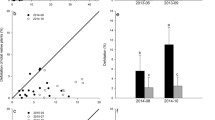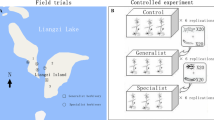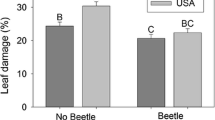Abstract
Many invasive plant species have high tolerance to herbivore damage, which can lead to low impacts of introduced biological control insects. High herbivore tolerance may be a trait acquired by invasive plants in their invaded range which makes it difficult to predict impacts of introduced insects. In this study, we compared the growth and foliar secondary chemical responses of invasive and native populations of Triadica sebifera (Chinese tallow tree) to repeated damage by specialist or generalist herbivores. We found repeated damage significantly decreased plant biomass and increased foliar tannin and flavonoid concentrations compared to a single damage event. These effects were significantly stronger with specialist damage than with generalist damage but the magnitudes of these differences were small. Plants from invasive populations had lower foliar tannins and higher foliar flavonoids than plants from native populations and had greater biomass in every damage treatment. Our results suggest that repeated damage could suppress the growth of invasive plants with high tolerance. Thus using multivoltine herbivores as biological control agents may overcome herbivore tolerance and increase biological control efficacy.


Similar content being viewed by others
References
Bale JS, van Lenteren JC, Bigler F (2008) Biological control and sustainable food production. Philos Trans R Soc B 363:761–776
Blossey B, Nötzold R (1995) Evolution of increased competitive ability in invasive nonindigenous plants: a hypothesis. J Ecol 83:887–889
Blumenthal D, Mitchell CE, Pysek P, Jarosık V (2009) Synergy between resource availability and pathogen releasein plant invasion. Proc Nat Acad Sci USA 106:7899–7904
Bossdorf O, Prati D, Auge H, Schmid B (2004) Reduced competitive ability in an invasive plant. Ecol Lett 7:346–353
Bruce KA, Cameron GN, Harcombe PA, Jubinsky G (1997) Introduction, impact on native habitats, and management of a woody invader, the Chinese tallow tree, Sapium sebiferum (L.) Roxb. Nat Areas J 17:255–260
Davis MA, Grime JP, Thompsom K (2000) Fluctuating resources in plant communities: a general theory of invasibility. J Ecol 88:528–534
DeWalt SJ, Siemann E, Rogers WE (2011) Geographic distribution of genetic variation among native and introduced populations of Chinese tallow tree, Triadica sebifera (Euphorbiaceae). Am J Bot 98:1128–1138
Dukes JS, Mooney HA (1999) Does global change increase the success of biological invaders? Trends Ecol Evol 14:135–139
Gerber E, Hinz HL, Blossey B (2008) Pre-release impact assessment of two stemboring weevils proposed as biological control agents for Alliaria petiolata. Biol Control 45:360–367
Huang W, Siemann E, Wheeler WS, Zou J, Carrillo J, Ding J (2010) Resource allocation to defence and growth are driven by different responses to generalist and specialist herbivory in an invasive plant. J Ecol 98:1157–1167
Huang W, Wheeler GS, Purcell M, Ding J (2011) The host range and impact of Bikasha collaris (Coleoptera: Chrysomelidae), a promising candidate agent for biological control of Chinese tallow, Triadica sebifera (Euphorbiaceae) in the United States. Biol Control 56:230–238
Julien M, Griffiths M (1998) Biological control of weeds: a word catalogue of agents and their target weeds, 4th edn. CABI Publishing, Wallingford
Koricheva J, Nykanen H, Gianoli E (2004) Meta-analysis of tradeoffs among plant antiherbivore defences: are plants jacks of all trades, masters of all? Am Nat 163:E64–E75
McFadyen R (1998) Biological control of weeds. Annu Rev Entomol 43:369–393
Meyer G, Clare R, Weber E (2005) An experimental test of the evolution of increased competitive ability hypothesis in goldenrod, Solidago gigantea. Oecologia 144:299–307
Milbrath LR (2008) Growth and reproduction of invasive Vincetoxicum rossicum and V. nigrum under artificial defoliation and different light environments. Botany 86:1279–1290
Müller-Schärer H, Schaffner U, Steinger T (2004) Evolution in invasive plants: implications for biological control. Trends Ecol Evol 19:417–422
Olson BE, Richards JH (1988) Tussock regrowth after grazing: intercalary meristem and axillary bud activity of tillers of Agropyron desertorum. Oikos 51:374–382
Olson BE, Wallander RT, Lacey JR (1997) Effects of sheep grazing on a spotted knapweed-infested Idaho fescue community. J Range Manage 50:386–390
Pattison RR, Mack RN (2008) Potential distribution of the invasive tree Triadica sebifera (Euphorbiaceae) in the United States: evaluating CLIMEX predictions with field trials. Glob Change Biol 14:813–826
Pearson DE, Callaway RM (2003) Indirect effects of host-specific biological control agents. Trends Ecol Evol 18:456–461
Raghu S, Dhileepan K, Treviño M (2006) Response of an invasive liana to simulated herbivory: implications for its biological control. Acta Oecol 29:335–345
Ridenour WM, Vivanco JM, Feng Y, Horiuchi J, Callaway RM (2008) No evidence for trade-offs: centaurea plants from America are better competitors and defenders. Ecol Monogr 78:369–386
Rogers WE, Siemann E (2003) Effects of simulated herbivory and resources on Chinese tallow tree (Sapium sebiferum, Euphorbiaceae) invasion of native coastal prairie. Am J Bot 90:243–249
Rogers WE, Siemann E (2004) Invasive ecotypes tolerate herbivory more effectively than native ecotypes of the Chinese tallow tree Sapium sebiferum. J Appl Ecol 41:561–570
Rogers WE, Siemann E (2005) Herbivory tolerance and compensatory differences in native and invasive ecotypes of Chinese tallow tree (Sapium sebiferum). Plant Ecol 181:57–68
Rosenthal JP, Kotanen PM (1994) Terrestrial plant tolerance to herbivory. Trends Ecol Evol 9:145–148
Sampedro L, Moreira X, Zas R (2011) Costs of constitutive and herbivore-induced chemical defences in pine trees emerge only under low nutrient availability. J Ecol 99:818–827
Siemann E, Rogers WE (2003a) Increased competitive ability of an invasive tree may be limited by an invasive beetle. Ecol Appl 13:1503–1507
Siemann E, Rogers WE (2003b) Reduced resistance of invasive varieties of the alien tree Sapium sebiferum to a generalist herbivore. Oecologia 135:451–457
Siemann E, Rogers WE, DeWalt SJ (2006) Rapid adaptation of insect herbivores to an invasive plant. Proc R Soc B 273:2763–2769
Smith L (2005) Host plant specificity and potential impact of Aceria salsolae (Acari: Eriophyidae), an agent proposed for biological control of Russian thistle (Salsola tragus). Biol Control 34:83–92
Stamp N (2003) Out of the quagmire of plant defence hypotheses. Q Rev Biol 78:23–55
Striker GG, Manzur ME, Grimoldi AA (2011) Increasing defoliation frequency constrains regrowth of the forage legume Lotus tenuis under flooding: the role of crown reserves. Plant Soil 343:261–272
Underwood N (2012) When herbivores come back: effects of repeated damage on induced resistance. Funct Ecol 26:1441–1449
USDA/NRCS (2016). Plants profile: Triadica sebifera (L.) small Chinese tallow tree. (http://plants.usda.gov/core/profile?symbol=TRSE6)
van Kleunen M, Schmid B (2003) No evidence for evolutionary increased competitive ability (EICA) in the invasive plant Solidago canadensis. Ecology 84:2824–2831
van Lenteren JC, Bueno VHBP (2003) Augmentative biological control of arthropods in Latin America. BioControl 48:123–139
Wang Y, Huang W, Siemann E, Zou J, Wheeler GS, Carrillo J, Ding J (2011) Lower resistance and higher tolerance of invasive host plants: biocontrol agents reach high densities but exert weak control. Ecol Appl 21:729–738
Wang Y, Siemann E, Wheeler GS, Zhu L, Gu X, Ding J (2012a) Genetic variation in anti-herbivore chemical defenses in an invasive plant. J Ecol 100:894–904
Wang Y, Zhu L, Gu X, Wheeler GS, Purcell M, Ding J (2012b) Pre-release assessment of a noctuid Gadirtha inexacta (= Iscadia inexacta) proposed as a biological control agent of Chinese tallow (Triadica sebifera) in the United States. Biol Control 63:304–309
Weis AE, Simms EL, Hochberg ME (2000) Will plant vigor and tolerance be genetically correlated? Effects of intrinsic growth rate and self-limitation on regrowth. Evol Ecol 14:331–352
Zas R, Moreira X, ampedro SL (2011) Tolerance and induced resistance in a native and an exotic pine species: relevant traits for invasion ecology. J Ecol 99:1316–1326
Zhang KD, Lin YT (1994) Chinese Tallow. China Forestry Press, Beijing
Zou JW, Rogers WE, Siemann E (2008a) Increased competitive ability and herbivory tolerance in the invasive plant Sapium sebiferum. Biol Invasions 10:291–302
Zou JW, Siemann E, Rogers WE, Dewalt SJ (2008b) Decreased resistance and increased tolerance to native herbivores of the invasive plant Sapium sebiferum. Ecography 31:663–671
Zou JW, Rogers WE, Siemann E (2009) Plasticity of Sapium sebiferum seedling growth to light and water resources: inter- and intraspecific comparisons. Basic Appl Ecol 10:79–88
Acknowledgments
We would like to thank Xue Gu for field assistance, two reviewers and editor’s comments improved our manuscript. This study was supported by the China National Basic Study Program (2012CB114104 to J.D.), the US National Science Foundation (DEB 0820560 to E.S.), a Foreign Visiting Professorship of the Chinese Academy of Sciences (to E.S.), the Chinese National Science Foundation (Y411041H01 to Y.W.) and Youth Innovation Foundation by Chinese Academy of Sciences (Y329341H02 to Y.W.).
Author information
Authors and Affiliations
Corresponding author
Additional information
Handling Editor: S. Raghu
Electronic supplementary material
Below is the link to the electronic supplementary material.
Rights and permissions
About this article
Cite this article
Wang, Y., Zhu, L., Siemann, E. et al. Repeated damage by specialist insects suppresses the growth of a high tolerance invasive tree. BioControl 61, 793–801 (2016). https://doi.org/10.1007/s10526-016-9746-z
Received:
Accepted:
Published:
Issue Date:
DOI: https://doi.org/10.1007/s10526-016-9746-z




